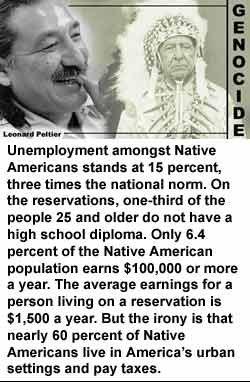- Letters from Leonard Peltier – Part I (12/22/2003)
- The Case of Leonard Peltier; Native American Political Prisoner

(FinalCall.com) – In the last issue (Volume 23, Number 12) of The Final Call, Native American activist Leonard Peltier talked about a young man named John Boy Graham, who was recently arrested for the murder of American Indian Movement activist Anne Mae Pictou-Aquash. The young woman was murdered in 1975, a bad time for Native American activists such as Mr. Peltier, who has been in federal prison for 27 years for the murder of two Federal Bureau of Investigation agents during a shoot-out on the Pine Ridge Reservation, also in 1975.
Mr. Peltier’s second letter concerned the guilty verdict against South Dakota Republican Congressman William Janklow, 64, who was convicted of running a stop sign, speeding and second-degree manslaughter, in the death of a motorcyclist.
Speaking of the irony of the guilty verdict, Mr. Peltier wrote: “This decision is from a state that historically practiced a program of polarization and racism toward Native people, a state where [Wm.] Janklow, as attorney general, called in a riot squad to beat and eject all courtroom observers who would not stand for the judge.
“I could revel in the conviction of Janklow; however, it does not change the terrible conditions that my people face daily. I surely doubt he’ll miss a meal or look in the faces of children on the reservation or other Native Americans in areas where the people have been taught to celebrate Xmas, and yet receive nothing but despair. I sincerely wish they would sentence him the same way they would sentence a Native American.”
According to Bureau of Criminal Justice, FBI statistics and the 2000 Census, on any given day, one in 25 Native Americans, ages 18 and older, are under the jurisdiction of the criminal justice system in some form or fashion; 2.4 times the number of Whites and 9.3 times the number of Asians. In 1999, it was reported that 63,000 Native Americans were in jails and prisons.
An alarming statistic is that Native Americans suffer violent crimes at two-and-a-half times the national rate. Seventy percent of those who commit violence against Native Americans are from another race or ethnic group.
Now, let’s tie all this together.
In 1973, Mr. Janklow was hired as the chief prosecutor for the South Dakota attorney general’s office, mainly to prosecute Native American activists. He was elected attorney general in 1974, and became governor for four terms. In 2002, he was elected to Congress. Native American activists refer to Mr. Janklow as “the Indian fighter.”
The Census Bureau says that Buffalo County, South Dakota, is the poorest county in America, with 56 percent of the people living below the poverty line. It is the home to the Crow Creek Native American reservation. Five out of the 10 poorest counties in America are located in South Dakota. Mr. Peltier said that men such as Congressman Janklow continued to stifle any attempt by Native Americans to change their lives.
Unemployment amongst Native Americans stands at 15 percent, three times the national norm. On the reservations, one-third of the people 25 and older do not have a high school diploma. Only 6.4 percent of the Native American population earns $100,000 or more a year. The average earnings for a person living on a reservation is $1,500 a year. But, the irony is that nearly 60 percent of Native Americans live in America’s urban settings and pay taxes.
But, as Mr. Peltier points out, there is a change coming over the horizon. Native Americans in states such as South Dakota are starting to use the vote to bring about change in spite of the efforts of people such as the deposed Congressman. In February 2003, the state legislature introduced House Bill 1176, which requires voters to show an identification card before casting their vote.
The American Civil Liberties Union of the Dakotas said the law is in violation of the Voting Rights Act, because it has the effect of discriminating against Native American voters.
Activists charge that following the local elections in 2002, Republicans attacked the record high Native American voter turnout, alleging fraud, although investigations turned out negative.
In an April 2002 editorial, USA Today said: “Native Americans continue to be the most deprived people in America.”
The fifth deadliest disease in the U.S. is diabetes, and 14.5 percent of the Native American population has it. One Native American nation in Arizona has the highest rate of diabetes in the world, with 50 percent of the adults between the ages of 30 to 64 affected, according to USA Today.
Observers and analysts say that it has been the policies of the American government that has caused such a negative effect on a people that once totaled 40 million before the arrival of Christopher Columbus. By the end of the 19th century, there would be less than 250,000 Native Americans left alive.
“From the forced relocations and so-called assimilation of the ‘savage’ to the White man’s way of life; to the forced sterilization of Native Americans, agencies such as the Bureau of Indian Affairs set out to destroy all things Indian,” Lindsay Glauner writes in the DePaul University Law Review. She is a judicial law clerk for the Immigration Court in Los Angeles.
On September 8, 2000, the head of the Bureau of Indian Affairs formally apologized for the agency’s participation in the “ethnic cleansing” of the Western Native American nations.
“Every aspect of the United Nations definition of genocide exactly corresponds to what happened to Native Americans,” columnist Rebecca L. Adamson writes in the Indian Country Today newspaper.
“America has a terrible day of reckoning ahead for the treatment of my people,” Mr. Peltier writes.












